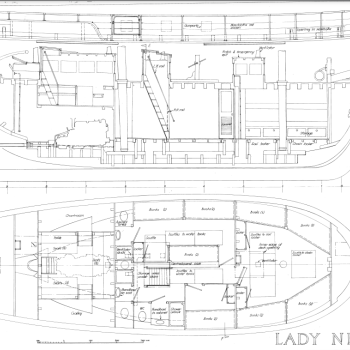1799 - 1800
The original Lady Nelson was built at Deptford, in England, in 1799, for service to the Transport Office on the River Thames. She was designed with a sliding keels (centre boards), a device invented by Captain John Schank of the Royal Navy. On completion she was selected for exploration services in the Colony of New South Wales and sailed for Port Jackson on 18 March 1800 under the command of Lieutenant James Grant.
A brig of 60 tons, she carried a crew comprising the commander, two mates and twelve seaman. As she left the River Thames sailors on nearby ships ridiculed her because of her size and shape, calling her, as she sailed past, 'His Majesty's Tinderbox'. At Portsmouth on the 9th February 1800 she was fitted with four brass carriage guns, three to four pounders, in addition to the two guns already on board.
Because of the heavy load she was carrying she was very low in the water, having only two feet nine inches freeboard amidships. The ship finally left Portsmouth on 17th March 1800 as part of an East Indian Convoy.
After leaving the convoy on 23rd March, the ship sailed on alone and arrived at St. Jago, Cape Verde islands on 13 April 1800. Two of the crew made off with one of the ship's boats. They were, however, soon captured by the Portuguese and brought back to the ship - "both riding the one ass". Dissension and unrest amongst the crew had been stirred up by the second mate and Grant sent him back to England. Two Young Portuguese men were signed on as crew.
As she sailed into Table Cape, South Africa on the 8th July 1800, the crew of Lady Nelson saw a convoy of ships that had left England at the same time. These ships had suffered heavy damage from rough weather and yet the Lady Nelson had survived the journey without mishap.
It was here that Grant received dispatches from the Duke of Portland, advising him of the discovery of a Strait between New South Wales and Van Dieman's Land, and that he was to sail through it on his way to Port Jackson, instead of sailing around Van Dieman's Land.
On leaving the Cape on 7th October 1800, she took on board Dr. Brandt, a ship's surgeon who had been wrecked at Delagoe Bay some years earlier. Grant also secured a ship's carpenter for the journey, He had to refuse many offers from young seaman who wished to join the Lady Nelson on her journey of discovery.
One of these was John Johnston (also known as Jorgen Jorgenson) who was sorely disappointed when he was refused. Grant was, however, obliged to take a fellow Dane, a convict who had to be transported to Port Jackson.
At daybreak on 3rd December 1800 in latitude 38º south, the crew first sighted the land of New Holland (near the present Mount Gambier). A few days later she sailed through Bass Strait, becoming the first ship to sail from west to east through the strait, charting the then unknown coastline. She entered the Heads at Port Jackson at six in the evening of December 16th after a passage of seventy-one days from Cape Town.

